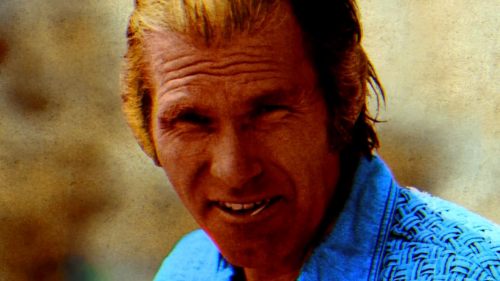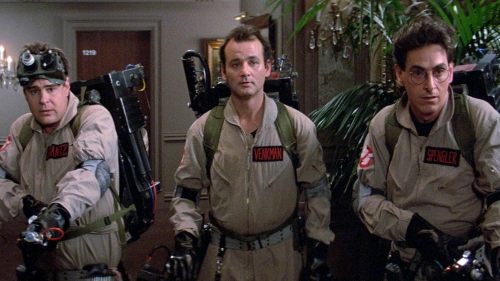Collins’ Crypt: Happy Birthday To BLAIR WITCH’s Unseen Terrors
From the point I got my own car, I had three movie theaters within reasonable (15 minute) driving distance, and wasn't yet the type to embrace anything that wasn't a wide release, so I never had to visit any others. But I made my first exception in the summer of 1999, driving into Boston (Cambridge, specifically) to the Kendall Square Cinema to see a movie I didn't want to wait another week or two to hit wide release. That film was The Blair Witch Project, which I was already mildly obsessed with thanks to seeing the trailer months earlier and spending a few days being quite sure it was a legit "documentary" and not a staged narrative feature (the illusion was shattered when one of those online sites I frequented noted that two of the actors were present for a screening). Still, even without the pretense that it might be real, I was still excited to see it, and 82 minutes later I had no regrets about driving the extra 25 minutes or so (plus - gasp! - paying for parking for probably the first time!).
And now that it's been around for 20 full years (and I can say with some pride that my BWP T-shirt, bought later that summer, still fits), I likewise have no regrets about my continued love of the movie as well as all of the supplemental media that came after it. No, neither sequel fully lived up to the first film, the YA books are kind of cheesy (and so tangentially related to the lore that I wouldn't be surprised if they were written prior to the movie's existence and given a quick edit to tie them in), and I probably will never listen to "Josh's Blair Witch Mix" soundtrack CD again, but the idea of this mythology, with all its weird diversions, makes me smile, and if nothing else tends to inspire another viewing of the movie that I still find riveting.
The same goes for all of the found footage movies that have come since, even though only maybe one out of every five I've seen has ever been that good (optimistic guess), with maybe a tenth of THOSE even coming close to holding a candle to Josh, Heather, and Mike's trip through the woods. Paranormal Activity is perhaps the only one that really measured up for me in that "I kind of believe this might be real" way, and I chalk a large part of that up to the circumstances that I saw it: at a film festival with zero fanfare, two years before it opened in theaters. At that time it didn't even have an IMDb page, and director Oren Peli was playing up the reality angle for the time being, so I bought into it for a while, much like many did when they sat down for Blair Witch Project and I assume absolutely no one in the world ever did for the likes of Apollo 18 or, well, any of the half dozen Paranormal Activity sequels.

Now of course someone's already gearing up to write their "Well actually..." style comments about Cannibal Holocaust and/or The Last Broadcast, and that's fine. We're all used to it and they can keep shouting into the void about how two films that were clearly presented as fictional films* "beat" BWP to the punch and deserve all the acclaim. And I'm all for giving credit where credit is due, but there's a reason BWP is the most famous of the lot: the footage WAS real. No, not the Blair Witch legend - Rustin Parr, Elly Kedward, etc. are all totally fictitious, dreamed up by Eduardo Sanchez, Daniel Myrick, and Ben Rock and primarily used as filler for the website and promo documentary specials. That stuff makes up maybe 10 minutes (at most) of the film, but the rest of it is, for all intents and purposes, far more "real" than the footage you see in pretty much every other "found footage" movie before or since, and pointedly never reminds you that you're watching a traditional movie with actors the way those others did.
For those who aren't well-versed in the production history of the film, the actors were not working from a traditional script. Each day, they would wake up to a new box of basic supplies (such as granola bars and water), fresh tapes/batteries for their camera/audio recording equipment, and a brief set of notes for each actor that would inform them of what they had to do that day, which they would not share with the others. While the more overt "scary movie" was stuff was staged by the Haxan Films crew, the three actors really were out there for a week with minimal contact, sleeping in their tent, and getting on each other's nerves with no trailer to retreat to. So on the 3rd or 4th day, when Mike tells the other two that he kicked the map into the river, their anger is not scripted or rehearsed - it's 100% genuine, as the other two had no idea that he was the culprit behind its disappearance, and were exhausted from blaming each other for it. Similarly, when Josh disappears later on, the others were not told about it and Josh himself didn't even know the full extent of it - he just had his (secret) instruction to leave the tent at one point when the others were sleeping, and he was pulled out of the woods with Mike and Heather having no warning about his absence.
Also, and this is an important element that is often forgotten: the actors shot just about every frame in the movie themselves (there are some brief portions in the opening when they're interviewing locals that were added later by the filmmakers to clarify some of the film's ending). As it turns out, while they were given crash courses in using the cameras, their documentary probably wouldn't have won any awards if they had survived long enough to finish it, and I think that's a big part of why the movie works. There's a pretty great example during the sequence when they are chased out of their tent in the middle of the night, as Heather shrieks "WHAT IS THAT???" but we only see shaky footage of Heather herself. Had Josh panned his camera to the side, he (and us in the audience) would have seen a spooky image of one of the crew members dressed entirely in white stockings, running alongside of them. A cameraman would have done that, for sure, but a tired, hungry, and probably very freaked out person holding a camera primarily as a light source would not.

So our imaginations have to take over instead - something few other found footage directors have dared try since (even the direct sequel, 2016's simply titled Blair Witch, employed traditional camera operators). Time after time I have been watching these things and rolled my eyes at a moment where a character stands there and films their friend being eaten by zombies or something, and that's the result of a filmmaker wanting to make sure he got the money shots, and a trained operator holding the camera instead of an in-character actor who might react differently (i.e. run, or help their loved one). Much like Jaws is probably a better movie because Bruce wouldn't cooperate, I'd be willing to bet Blair Witch Project would be a much lesser film - even with the exact same dialogue and sequence of events - if DP Neal Fredericks or someone else was operating the cameras themselves while the actor stood behind him to say their lines, or if they had the money to reshoot things like the white ghost when the actors messed it up. It's their innocent mistakes and "caught up in the moment" cinematography (i.e. aiming the camera at the ground during a heated argument) that sell the reality of the film - the relative professionalism of those that have come since always keeps you at arm's length, even if it's just subconsciously so.
Now, I am not saying that there haven't been any good films of this type since. I already gave Paranormal Activity its due, to which I'll add Cloverfield, [Rec] and its first sequel, and Paranormal Activity 3 as notable exceptions among the more famous ones, and there are lesser known films like Home Movie and Willow Creek that I found quite impressive. Another dozen or so, like The Visit and The Possession of Michael King, are perfectly enjoyable one-time watches. But they all lacked that crucial "this feels real" ingredient; their effectiveness came from other, more traditional areas, and they offered a polish that BWP didn't bother to include (to its benefit). Indeed, after Artisan bought the film they spent a considerable amount of money shooting at least four different endings that were more visually interesting than a guy standing a corner (one had Mike strung up from the ceiling, surrounded by stickmen), only to discover that a guy standing in a corner without knowing if he was even alive was far more terrifying than seeing the horror genre's 10,000th definitely dead body.
Long story short, it's the simplicity and genuine mistakes that give the film its power, and why it can still work on those who allow it to do so. I've probably seen it thirty times at this point and I still find myself fully engaged; even my rewatch for the purpose of this article - figuring it'd be something I'd just have on in the background - turned into a fairly rapt viewing. I know the film has its detractors and I understand their criticisms, but not one of them has ever been an issue for me (I don't even have a problem with the shaki-cam; if you ask me, nothing in the film is as disorienting or headache-inducing as the average fight in a Transformers sequel), and I am still comfortable referring to it as one of my all time favorite horror films. And now that I've done the math I realize I've been enjoying it for more than half the time I've been alive, which is a pretty good sign that a movie "holds up", in my opinion. Not bad for a movie where "nothing happens".
*Cannibal Holocaust's "found footage" section is only around half of the runtime, as the first half of the movie is actually about the guys who, well, find the footage. And Last Broadcast is presented as a traditional documentary with talking heads and the like, only to drop the pretense for its (misguided) final ten minutes and shoot it like a traditional feature.



